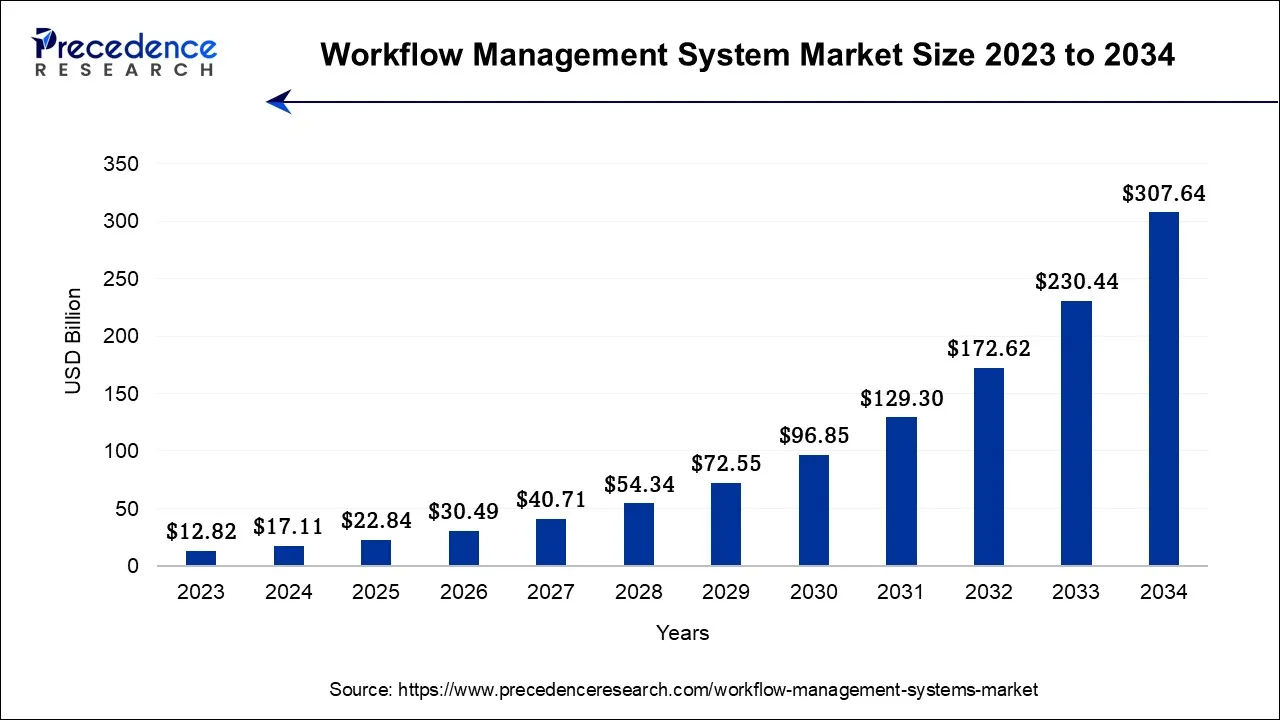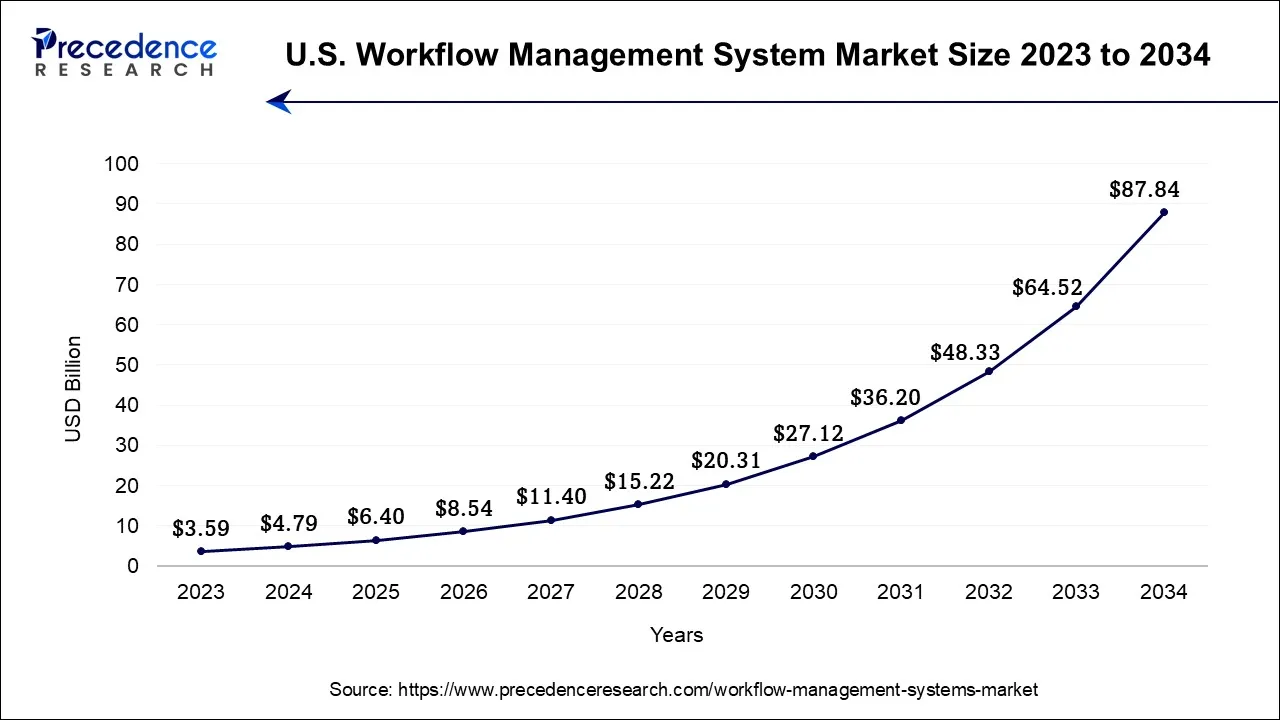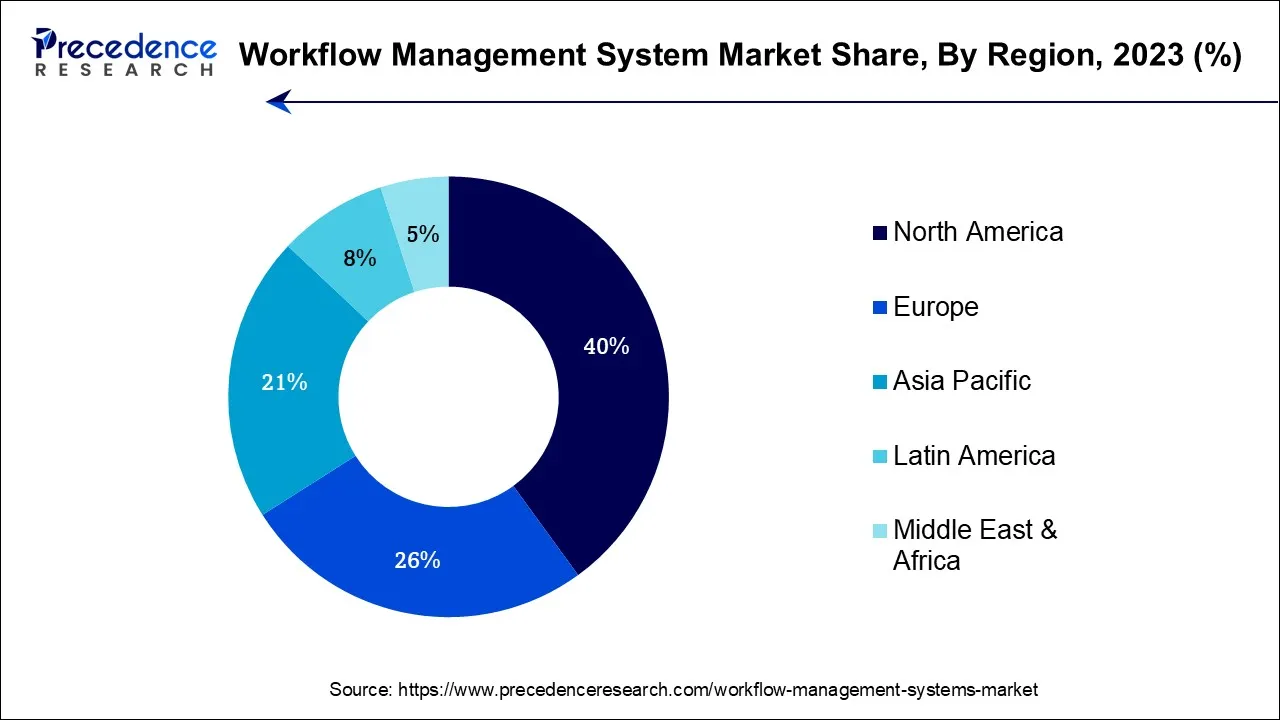August 2024
The global workflow management system market size is calculated at USD 17.11 billion in 2024, grew to USD 22.84 billion in 2025, and is predicted to hit around USD 307.64 billion by 2034, poised to grow at a CAGR of 33.5% between 2024 and 2034. The North America workflow management system market size accounted for USD 6.84 billion in 2024 and is anticipated to grow at the fastest CAGR of 33.67% during the forecast year.
The global workflow management system market size is expected to be valued at USD 17.11 billion in 2024 and is anticipated to reach around USD 307.64 billion by 2034, expanding at a CAGR of 33.5% over the forecast period from 2024 to 2034.

The U.S. workflow management system market size is accounted for USD 4.79 billion in 2024 and is projected to be worth around USD 87.84 billion by 2034, poised to grow at a CAGR of 33.76% from 2024 to 2034.

North America held the largest revenue share in 2023. The US dominated the North America region in 2023. The increasing adoption of digital transformation strategies along with rapid integration of process automation in the region has created a favorable environment for the growth of the workflow management system market during the forecast period. Furthermore, the increasing focus on data security is also likely to support the regional growth of the market. During the transition from legacy to new-age technologies, a workflow management system solution is significant in ensuring the security and safety of data.

Asia-Pacific is expected to grow at the fastest CAGR during the forecast period. The regional growth of the workflow management system market is expected to be boosted during the forecast period due to the rising demand for eliminating task redundancies and promoting productivity and efficiency. Furthermore, the region is witnessing economic growth as well as industrial development creating an environment for the adoption of advance technologies. This is also expected to support the growth of the market within the estimated timeframe. Additionally, the rising need for collaboration and communication along with growing IT infrastructure is also anticipated to contribute to the growth of the market in the region.
A workflow management system (WFMS) is a specialized software tool utilized to establish, oversee, and execute workflows within organizations. This approach integrates both software programs and human resources into a cohesive process structure. By enhancing efficiency and cutting operational expenses, workflow management systems offer valuable business process management capabilities. These systems typically streamline workflows, processes, and automation.
The surge in demand for workflow management systems can be ascribed to the increasing necessity for corporate process modernization. Additionally, the ongoing digital transformation across industries has been a major driver for the adoption of WMS solutions. Organizations strive to modernize their processes and become more efficient, thus they are increasingly turning to WMS to automate workflows, reduce manual tasks, and improve overall productivity.
Workflow management systems offer robust process automation capabilities, allowing businesses to streamline their operations and achieve higher levels of efficiency. With automation, organizations can eliminate bottlenecks, reduce errors, and accelerate task completion, leading to cost savings and enhanced competitiveness. The growing popularity of cloud-based solutions has provided significant opportunities for the WMS market. Cloud-based WMS offers greater flexibility, scalability, and cost-effectiveness, making it accessible to businesses of all sizes. It also facilitates remote access, enabling organizations to manage workflows from anywhere, which became even more critical during the COVID-19 pandemic and the rise of remote work.
Furthermore, the implementation of workflow management software is expected to drive market growth, primarily due to its associated benefits, such as cost efficiency, improved resource utilization, and enhanced business processes. As businesses expand and encounter changes in their operations, the increased handling of larger data volumes and additional functionalities creates a demand for workflow management software. These factors are set to fuel the continued growth of the workflow management system market. Also, the integration of AI and machine learning technologies into WMS platforms offers opportunities for intelligent process automation, predictive analytics, and continuous improvement, further enhancing the value proposition of these systems.
| Report Coverage | Details |
| Market Size in 2024 | USD 17.11 Billion |
| Market Size by 2034 | USD 307.64 Billion |
| Growth Rate from 2024 to 2034 | CAGR of 33.5% |
| Largest Market | North America |
| Base Year | 2023 |
| Forecast Period | 2024 to 2034 |
| Segments Covered | Component, Deployment, Vertical, and Region |
| Regions Covered | North America, Europe, Asia-Pacific, Latin America, and Middle East & Africa |
Increasing need for transforming customer and employee experience
Undoubtedly, once individuals experience the convenience of mobile apps they become unwilling to revert to the old ways. As a result, expectations for interfaces and overall service excellence escalate, necessitating companies to adapt to stay competitive. Surveys show that 84% of organizations that prioritize enhancing customer experience observe a subsequent increase in revenue. It is no surprise that customer experience has become the new battleground, with 89% of businesses soon expected to compete primarily based on this factor, according to Gartner surveys. Additionally, meeting employee expectations is equally crucial, as failing to do so can lead to reduced loyalty, increased turnover, and related expenses.
Companies recognize the importance of structured onboarding programs, as employees who undergo such programs are 58% more likely to remain with the organization for three years. In response to new employee expectations, many companies are implementing automated onboarding processes, supported by workflow management software, to streamline and expedite employee assessment, hiring, training, and onboarding workflows. Furthermore, employees expect a unified platform for accessing IT, procurement, HR, and other internal services. This trend revolves around integrating user-friendly interfaces, customer mapping, multi-device accessibility, artificial intelligence, and various other features to continuously enhance services for both customers and employees. When selecting a workflow management tool, it is essential to ensure its capacity to support service improvement initiatives. However, workflow management systems is significant in this transformation by automating and optimizing workflows, allowing organizations to deliver faster, more personalized, and efficient services to their customers.
Data privacy and security issues
Amidst the emergence of a new breed of online criminals during the pandemic, many business leaders continue to rely on manual processes to safeguard against online data theft. By depending solely on physical security measures, they may avoid the need to adapt to ever-evolving hacking techniques. However, while manual workflows may offer short-term protection, they do not absolve businesses of potential risks, including data loss and potential downtime. To address these challenges, it is imperative to select a workflow automation tool equipped with advanced security features to safeguard the collected data.
A prudent approach involves opting for a solution with top-tier workflow automation features, such as database encryption, password protection, and workflow tracking. By ensuring these innovative security measures are in place, businesses can gain real-time insight into the status of their workflows, promptly identify any threats, and swiftly take action to resolve them. Embracing such a security-focused workflow automation tool empowers organizations to proactively protect their data and defend against evolving cyber threats, ensuring a more robust and secure operational environment.
Collaboration of RPA and workflow management
The collaboration of RPA and workflow management is likely to offer growth opportunities for the workflow management system market in the years to come. The adoption of RPA (Robotic Process Automation) is rapidly increasing due to the efficiency of bots in handling low-level and repetitive tasks, often replacing human involvement. Early adopters in shared services and administrative organizations have already experienced significant benefits from RPA implementation. According to the 2018 Deloitte Global RPA Survey, 53% of respondents had embarked on their RPA journey, with substantial improvements observed across various dimensions, including enhanced compliance (92%), improved quality/accuracy (90%), increased productivity (86%), and cost reduction (59%).
However, it is essential to recognize that bots are limited when dealing with implicit processes, a capability humans possess. As a result, many businesses are adopting a combined approach, leveraging both RPA and workflow management technologies. In this model, bots and humans collaborate to complete workflow tasks, with task assignment and flow control managed by the workflow management solution. This integrated approach is gaining popularity, and it is foreseeable that future scenarios will require close cooperation between humans and bots. Therefore, it is crucial for businesses to ensure that their workflow management software offers an open API for seamless integration with RPA systems and supports effective human-bot collaboration.
On the basis of software, the production workflow system segment held a considerable revenue share in 2023. Implementing production workflow software leads to reduced overhead costs, time savings, increased profitability, and improved visibility into the production processes within the business. It significantly reduces overhead costs by streamlining and automating production processes, eliminating the need for excessive manual interventions and optimizing resource allocation. This reduction in overhead expenses allows businesses to allocate their financial resources more efficiently, thereby enhancing overall financial health and sustainability.
As businesses seek to optimize their production workflows, they are turning to advanced software solutions that streamline operations, reduce manual interventions, and enhance overall efficiency. These factors are likely to create opportunities for the segment growth of the workflow management system market during the forecast period.
Based on the application, the BFSI segment held the largest market share in 2023. Utilizing workflow management software enables the banking industry to streamline and optimize various processes. Traditional credit card application processing often consumes significant time, leading to customer dissatisfaction. However, with the implementation of hyper-automation, banks can expedite this workflow. By collating and verifying information, running background checks, and assessing customer eligibility within a few hours, the workflow management software facilitates faster credit card processing, ultimately enhancing customer satisfaction and retention.
Furthermore, ensuring accurate and up-to-date general ledgers is crucial for effective financial information tracking in banks. Hyperautomation proves instrumental in improving the accuracy and efficiency of general ledger management. Equipped with predefined rules, the workflow management software automates the process of updating liabilities, assets, expenses, and revenue in the general ledger. This reduction in manual data entry and automated calculations results in maintaining error-free general ledgers with an impressively quick turnaround time. Embracing hyper-automation in this aspect significantly contributes to improved financial reporting and regulatory compliance, solidifying the overall efficiency and reliability of banking operations.
Segments Covered in the Report
By Component
By Deployment
By Vertical
By Geography
For inquiries regarding discounts, bulk purchases, or customization requests, please contact us at sales@precedenceresearch.com
No cookie-cutter, only authentic analysis – take the 1st step to become a Precedence Research client
August 2024
April 2025
September 2024
November 2024